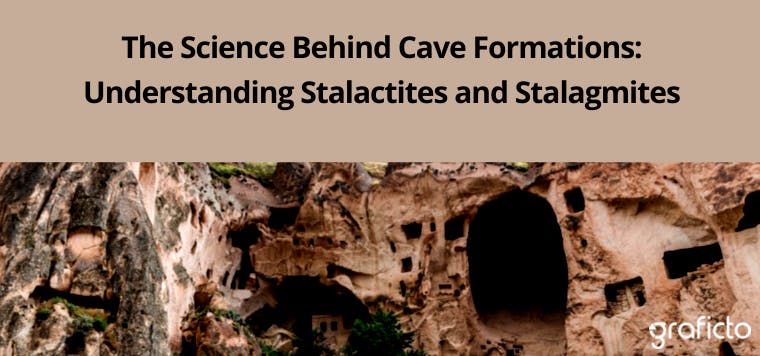
This infographic was created using Graficto.
Caves are natural wonders that house some of the most fascinating geological formations on Earth. Among these formations, stalactites and stalagmites are particularly intriguing due to their unique structures and slow, yet persistent, growth over time. Understanding the science behind these formations offers valuable insights into cave geology, mineral deposition, and Earth's natural history. In this article, we will explore the geological processes responsible for their formation, their significance, and the role environmental factors play in their development.
What Are Stalactites?
Definition and Characteristics
Stalactites are icicle-like mineral deposits that hang from the ceilings of caves. They are primarily composed of calcium carbonate (CaCO₃) and form as water seeps through limestone, leaving behind mineral traces.
Composition and Common Locations
Most stalactites are made of limestone-based calcite or aragonite, though they can also contain minerals such as gypsum or quartz in non-limestone environments. They are commonly found in karst caves, which are formed by the dissolution of soluble rocks such as limestone, dolomite, and gypsum.
Formation Process of Stalactites

This infographic was created using Graficto.
Role of Mineral-Rich Water
Stalactites form as water, carrying dissolved calcium carbonate, drips from cave ceilings. As the water reaches the air, carbon dioxide (CO₂) escapes, leading to the deposition of calcite.
Chemical Reactions Leading to Stalactite Growth
The key reaction behind stalactite formation is:

Here, carbonic acid (H₂CO₃) dissolves calcium carbonate in the rock, and when CO₂ is released from the dripping water, calcite (CaCO₃) precipitates to form stalactites.
Factors Influencing Stalactite Growth
Growth rates depend on several factors:
- Water flow rate: More dripping means faster growth.
- Carbon dioxide levels: Higher CO₂ levels encourage calcite precipitation.
- Temperature and humidity: Stable cave conditions promote consistent formation.
Variations in Stalactite Structures
Soda Straws and Their Transformation
Soda straws are thin, hollow stalactites that develop as water drips through a central channel. Over time, they grow into full stalactites when the channel gets blocked.
Influence of Environmental Conditions
Different mineral compositions and varying drip rates lead to diverse stalactite shapes, including conical, drapery-like, and clustered formations.
What Are Stalagmites?
Definition and Distinguishing Features
Stalagmites are upward-growing formations on cave floors, directly underneath stalactites. They develop from mineral deposits left behind by dripping water.
Common Compositions and Formation Environments
Like stalactites, most stalagmites are made of calcite, aragonite, or gypsum, forming in humid karst cave systems where mineral-laden water is abundant.
Formation Process of Stalagmites
Deposition of Minerals from Dripping Water
As water drips from the ceiling and lands on the floor, calcite builds up, leading to stalagmite formation. The absence of air movement helps minerals accumulate without being disturbed.
Chemical Processes in Stalagmite Growth
The same calcium carbonate precipitation process governs both stalactites and stalagmites, with the primary difference being the location of deposition.
Factors Affecting Stalagmite Formation Rates
- Drip rate and volume: Faster dripping speeds up growth.
- Water chemistry: Higher dissolved mineral content promotes accumulation.
- Cave conditions: Temperature and humidity affect the stability of deposits.
Interactions Between Stalactites and Stalagmites
Formation of Columns
Over thousands of years, stalactites and stalagmites can meet and merge, forming columns or pillars.
Environmental Factors Influencing Their Connection
Consistent drip rates, stable temperature, and balanced humidity levels influence the likelihood of column formation.
Other Notable Speleothems
Flowstones, Helictites, and Cave Pearls
- Flowstones: Sheet-like calcite formations on cave walls or floors.
- Helictites: Twisted, gravity-defying formations created by capillary forces.
- Cave pearls: Spherical deposits formed by mineral-rich water tumbling small particles.
World’s Deepest and Longest Caves
Deepest Caves in the World
- Veryovkina Cave, Georgia - Depth: 2,212 meters (7,257 feet)
- Krubera Cave, Georgia - Depth: 2,197 meters (7,208 feet)
- Sarma Cave, Georgia - Depth: 1,830 meters (6,004 feet)
Longest Caves in the World
- Mammoth Cave, USA - Length: Over 680 km (422 miles)
- Sistema Sac Actun, Mexico - Length: 364 km (226 miles)
- Jewel Cave, USA - Length: 335 km (208 miles)
Fascinating Cave Facts
- Some caves, such as Waitomo Caves in New Zealand, are illuminated by glowworms, creating a magical starry effect.
- The Naica Crystal Cave in Mexico contains some of the largest natural crystals ever discovered, reaching up to 12 meters (39 feet) long.
- Hang Sơn Đoòng in Vietnam, the largest cave in the world by volume, has its own ecosystem with clouds, rivers, and jungles inside.
Significance of Stalactites and Stalagmites
Contributions to Understanding Geological History
Speleothems record climatic and geological changes, providing insights into past environmental conditions.
Importance in Paleoenvironmental Reconstruction
By analyzing speleothem layers, scientists reconstruct ancient rainfall patterns and ecosystem changes.
FAQs: Common Questions About Stalactites and Stalagmites
How long does it take for stalactites and stalagmites to form?
It takes 100–1,000 years for a typical stalactite to grow 1 cm, depending on conditions.
Can stalactites and stalagmites grow back if broken?
They can regrow over time, but the process is extremely slow.
What is the largest stalactite or stalagmite ever discovered?
One of the largest stalactites, over 60 feet long, is in the Jeita Grotto, Lebanon.
Are stalactites and stalagmites found outside of caves?
Yes, they can form in man-made structures, like mines and tunnels, called secondary speleothems.
How do human activities impact the growth of these formations?
Pollution, excessive tourism, and climate change can alter water chemistry and slow or stop growth.
Conclusion
The fascinating world of stalactites and stalagmites showcases the intricate and slow geological processes shaping our planet. Understanding their formation, growth conditions, and scientific significance allows us to appreciate the Earth's hidden wonders, from towering underground chambers to deep abyssal caves teeming with mystery and beauty.


